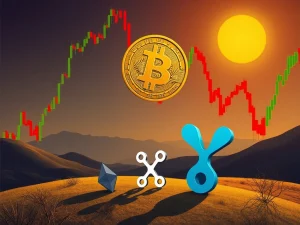Unmasking Altcoin Market Manipulation: 5 Critical Steps to Prevent Devastating Crashes

The altcoin market offers unparalleled opportunities for growth. However, it also presents significant risks. Many investors find themselves caught in the crossfire of organized schemes. Altcoin market manipulation poses a constant threat to unsuspecting traders. This comprehensive guide helps you identify the warning signs and protect your investments. You will learn how to recognize manipulative tactics before they lead to a devastating crash.
Understanding Crypto Market Manipulation Tactics
Crypto market manipulation involves coordinated efforts to artificially influence token prices. These schemes mislead traders about a token’s true value or demand. Manipulators exploit the high volatility and limited oversight common in altcoin markets. Their primary goals include securing profits for insiders or creating exit opportunities for early investors. Consequently, retail traders often suffer significant losses. Recognizing these strategies is crucial for self-preservation in this dynamic environment.
Common manipulation tactics used in altcoins include:
-
Pump-and-Dump Schemes: Insiders coordinate to inflate a token’s price. They often use social media hype to attract new buyers. When the price peaks, these insiders sell their holdings rapidly. This action triggers a sharp decline, leaving late entrants with heavy losses.
-
Wash Trading: Traders repeatedly buy and sell the same token. This generates artificial trading activity. Such actions create a false impression of robust market demand and liquidity. Subsequently, others are lured into buying the token at elevated prices.
-
Spoofing and Layering: Traders submit large buy or sell orders. They have no intention of executing these orders. These deceptive orders distort market perception. They suggest stronger demand or supply than actually exists. This often misleads others into making poor trades.
-
Insider Trading: Individuals with access to confidential information trade before public announcements. This information might include planned exchange listings or token releases. Therefore, they profit unfairly from price movements that others cannot anticipate.
-
Whale Manipulation: Major holders, known as “whales,” trade substantial amounts of a token. Their large purchases can fuel fear of missing out (FOMO) among retail investors. Conversely, sudden, massive sales often cause widespread panic. This allows whales to buy back at significantly lower prices.
Critical Warning Signs to Detect Altcoin Manipulation
Identifying red flags of market manipulation helps altcoin investors avoid sudden losses. On-chain and market data frequently provide early signals before a downturn. Therefore, vigilance is paramount. Here are some key warning signs to detect altcoin manipulation:
-
Sudden Increases in Trading Volume: A rapid surge in activity without a clear fundamental reason often signals coordinated buying. This aims to attract additional investors. Such an anomaly warrants immediate investigation.
-
Whales Transferring Funds to Exchanges: Large transfers from crypto wallets to exchanges, typically by whales, often suggest impending major sell-offs. This indicates insiders are preparing to liquidate their positions.
-
Sharp Price Fluctuations in Low-Liquidity Markets: Tokens with limited trading volume are highly susceptible to manipulation. Large price swings in these markets often indicate deliberate manipulation by small groups or individual actors. They can move prices with relatively small capital.
-
Upcoming Token Unlocks or Vesting Schedules: Upcoming token distributions increase the available supply. Early investors or project teams may use these unlocks to sell their holdings. This can exert significant downward pressure on prices.
-
Questionable Surges in Social Media Activity: Fake hype, repetitive hashtags, or sudden endorsements from obscure influencers could signal coordinated promotional campaigns. Many “trending” coins on platforms like X or Telegram gain traction through automated bot activity rather than genuine investor interest. This artificial buzz aims to create false demand.
Essential Tools to Prevent Altcoin Crash
Detecting market manipulation in altcoins demands attentiveness and the right analytical tools. From blockchain forensics to market scanners and social sentiment trackers, these resources help traders identify unusual patterns. They also expose deceptive behavior before losses occur. Utilizing these tools can significantly improve your ability to prevent altcoin crash scenarios. This proactive approach safeguards your capital.
Key tools and techniques include:
-
On-chain Analytics: Platforms such as Nansen, Glassnode, and Arkham Intelligence monitor wallet transactions. They track significant fund movements to identify coordinated manipulation or insider activity. This provides transparency into large-scale movements.
-
Market Scanners: Tools like CoinMarketCap’s liquidity metrics, DEXTools, and CoinGecko alerts track real-time trading activity. They flag unusual trading volumes, sudden liquidity changes, or price discrepancies across exchanges. All these are potential signs of fake volume or coordinated manipulation. These scanners offer immediate insights.
-
Social Sentiment Tools: Services such as LunarCrush and Santiment analyze public sentiment, keyword frequency, and influencer mentions. They detect artificial hype, coordinated campaigns, or FOMO-driven market behavior. This helps distinguish genuine interest from manufactured buzz.
-
Chart Indicators: Technical indicators like Relative Strength Index (RSI) divergence, sudden volume spikes, and rising whale ratios highlight abnormal buying or selling pressure. These often signal potential manipulation or coordinated activity. They offer a visual representation of market anomalies.
Manipulators frequently use social media to push their agenda and generate hype. Monitoring activity patterns on platforms such as X, Telegram, or Reddit helps traders spot suspicious trends. This can occur before they affect altcoin prices. Behavioral clues often reveal underlying manipulation. For instance, Telegram “pump-and-dump” groups often operate like secret clubs, offering paid entry tiers and “early alerts” for insiders.
Safeguarding Your Altcoin Investments from Exploitation
In the crypto market, vigilance and due diligence are your best safeguards against manipulation and deceit. Sound financial habits can significantly reduce your exposure to fraud. Therefore, prioritizing education and careful planning is essential. These tips help you protect altcoin investments effectively:
-
Verify Project Fundamentals: Always review the team, tokenomics, and development roadmap before investing. A strong foundation indicates genuine potential, not just speculative hype. Due diligence prevents many pitfalls.
-
Avoid Chasing Parabolic Price Moves: Sudden, rapid surges often signal coordinated price inflation rather than organic growth based on the project’s fundamentals. These unsustainable rallies typically precede sharp corrections.
-
Diversify Your Portfolio: Spread your holdings across multiple assets. This reduces the impact of any single token’s decline. Diversification is a cornerstone of risk management.
-
Set Stop-Loss and Take-Profit Limits: Use these automated tools to lock in profits and minimize potential losses during market volatility. They provide a disciplined approach to trading.
-
Follow Credible Sources: Rely on trusted news outlets, reputable data analytics platforms, and verified discussion forums. Avoid anonymous sources or those promising guaranteed returns.
-
Ignore FOMO-Driven Chatter: Avoid Telegram or X groups promoting “next 100x gems” without credible evidence or transparency. Such channels often serve manipulative purposes.
Real-World Cases of Altcoin Manipulation and Their Aftermath
Throughout altcoin history, several early warning signs have been ignored. This consistently led to severe losses for retail investors. These red flags often included excessive social hype, large wallet movements, or opaque token mechanics. Examining these past events offers valuable lessons. They highlight the devastating consequences of unchecked manipulation.
Here are a few notable examples:
-
Example 1: LIBRA Failure (February 2025): Argentine President Javier Milei promoted a new memecoin. It surged in value minutes after his post. However, within hours, several wallets dumped their holdings. This crashed the price and caused heavy losses for retail investors. The promotional post was later deleted. This case perfectly illustrates a classic pump-and-dump.
-
Example 2: Terra (May 2022): The project collapsed when its algorithmic stablecoin, TerraUSD (UST), failed to maintain its dollar peg. The system depended on an arbitrage mechanism linking UST and LUNA. As confidence eroded, UST lost its peg, falling toward $0.30 and below. Mass redemptions, reduced liquidity, and a cascading death spiral led to the collapse of both UST and LUNA. This catastrophic event demonstrated how manipulated token mechanics, combined with loss of trust, can result in complete market failure.
These cases reinforce a critical lesson: hype and manipulated token mechanics eventually result in dumping. Furthermore, some developers now fake audits or use AI-generated team photos to appear credible. They then vanish after attracting investments. This highlights the evolving nature of crypto scams.
Regulatory Efforts to Combat Crypto Market Manipulation
Regulators and crypto exchanges are strengthening oversight worldwide. Their goal is to curb crypto market manipulation. Leading exchanges have implemented advanced monitoring systems. These detect wash trading, spoofing, and coordinated order tampering. For example, Coinbase utilizes AI- and machine learning-powered trade surveillance. It also employs real-time monitoring to identify front-running and similar illicit activities. Such technological advancements enhance market integrity.
On the regulatory front, frameworks like the EU’s Markets in Crypto-Assets (MiCA) law have introduced greater order. The US Securities and Exchange Commission’s (SEC) enforcement actions also play a significant role. Furthermore, the Financial Action Task Force (FATF) has established clearer standards for transparency and accountability. These stricter regulations push projects and exchanges to adopt robust Know Your Customer (KYC) procedures. They also mandate internal transaction checks. Such measures by regulators and exchanges collectively strengthen investor protections. They foster greater confidence in the market, making it a safer space for legitimate participants.
This article does not contain investment advice or recommendations. Every investment and trading move involves risk, and readers should conduct their own research when making a decision.










